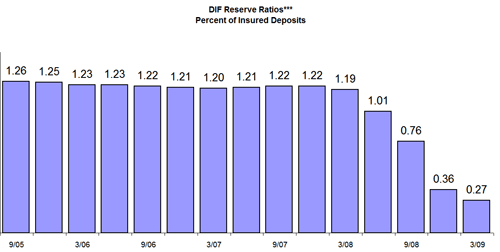Quarterly Banking Profile, March 31, 2009
On May 27, 2009, the FDIC released their Quarterly Banking Profile for the First Quarter of 2009.
Highlights of the FDIC report include the following:
- Banks reported earnings in the four quarter 61% lower than a year ago, earning a net profit of $7.6 billion. This was a major recovery from the $36.9 billion net loss reported in the fourth quarter of 2008. Despite this recovery from the fourth quarter, the banking industry continued to show major weakness as 22% of banks reported a net loss and 60% reported lower net income compared to the first quarter of 2008.
- Banks increased their loan loss provisions by $61 billion or 64% in the first quarter with 66% of the banks increasing loss provisions.
- Driven by rock bottom low short term interest rates, banks increased their net interest margin (NIM) to 3.39% in the first quarter, the highest NIM since second quarter 2006. Most of the improvement in NIM was concentrated in the larger institutions.
- Net charge-offs continued to rise in all major loan categories to $37.8 billion, twice as high as first quarter 2008.
- Noncurrent loans rose by $59.2 billion (25%), the largest quarterly increase in three years, to 3.76% of assets. The largest increase in noncurrent loans was in real estate which accounted for 84% of the total increase.
- The industry’s loan loss reserves increased by 11.5% to $20 billion and the ratio of reserves to total loans rose to 2.5%, an all time high from the previous record of 2.38% during the first quarter of 1992. Despite the all time high reserve ratio, the ratio of reserves to noncurrent loans fell to the lowest level in 17 years.
- Total equity capital of banks increased by $82 billion in the first quarter, the largest increase since third quarter 2004. Most of the increased equity capital occurred among a small number of larger banks. Total dividends paid by banks declined by 50% compared to last years first quarter.
- Total banking assets declined by $302 billion due to downsizing of loan portfolios and trading accounts at a small number of large banks. The decline in banking assets was the largest ever recorded for the past 25 years during which data was available.
- There were 21 banking failures during the quarter, the largest number since 1992. 50 banks were absorbed by mergers and 21 banks failed. During the past year ending March 31, 2009, there were 44 banking failures with combined assets of $381 billion.
- The number of banks on the FDIC’s “Problem Bank List” increased from 252 to 305 and total assets at problem banks rose from $159 billion to $220 billion.
- Insured deposits at the 8,246 FDIC insured banks (based on the $100,000 coverage limit) rose $82 billion to a total of $4.8 trillion.
- The FDIC Deposit Insurance Fund (DIF) decreased by $4.3 billion (25%) to $13 billion during the first quarter. The DIF’s reserve ratio declined to .27% at March 31, 2009, down from 1.19% a year ago. The March 31 DIF reserve ratio is at the lowest level since March 1993 when it was at .06%. The latest DIF ratio means that there is $270 backing up every $100,000 of insured deposits. Due to the very small amount of funds protecting insured banking deposits and to prevent possible public panic, the FDIC has recently taken steps to strengthen the DIF to protect banking deposits.

Speak Your Mind
You must be logged in to post a comment.